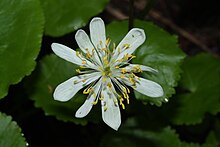|
Caltha leptosepala
Caltha leptosepala, the white marsh marigold, twinflowered marsh marigold, or broadleaved marsh marigold, is a North American species of flowering plant in the buttercup family. The species has regionally distinct variations. Description This is a perennial herb growing a mostly naked stem with leaves located basally. The leaves are up to 13 or 15 centimetres (5 or 6 inches) long and may have smooth, wrinkled, or toothed edges. The inflorescence bears one or more flowers. Each flower is 1 to 4 cm (1⁄2 to 1+1⁄2 in) wide and lacks petals, having instead petallike sepals which are usually white but sometimes yellow. In the center are many long, flat stamens and fewer pistils.[1] TaxonomyCaltha leptosepala used to be assigned to the Populago (now Caltha) section with all other Northern Hemisphere species, but genetic analysis suggests that it is the sister of all Southern Hemisphere species and should be moved into the Psychrophila section. C. leptosepala has two distinct subspecies (one of which has its own varieties).[a]
An additional type found in the Pacific Coast Ranges is treated as Caltha biflora.[4] Distribution and habitatC. leptosepala is native to western North America from Alaska to New Mexico, where it grows in wet mountain habitats in alpine and subalpine regions. It grows in moist to wet soils in partial shade. Its native habitats include wet alpine, subalpine meadows, stream edges and bogs.[1] ToxicityThe leaves contain toxic alkaloids, but are eaten by elk nonetheless.[5] UsesThe leaves and flower buds were eaten by some of the indigenous peoples of Alaska.[5] Notes
References
External linksWikimedia Commons has media related to Caltha leptosepala.
|
||||||||||||||||||||||||||||||||||||
